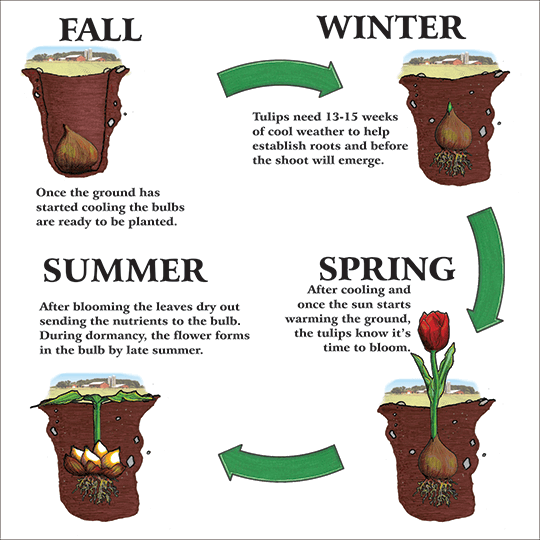How to Store Tulip Bulbs After They Bloom
6 Simple Steps for Successful Storage and Future Blooms

Why Store Tulip Bulbs?
Properly storing tulip bulbs after they bloom gives them a better chance of flowering again next season. While tulips are perennials in the wild, garden conditions often aren’t ideal for them to return with the same vigor year after year without intervention.
Following these steps will help preserve your tulip bulbs and ensure beautiful blooms in the next growing season.
Once your tulip flowers have faded and died, use pruning shears to cut off just the flower heads. This prevents the plant from using energy to produce seeds.
Important: Leave the green leaves and stems intact! The foliage continues to photosynthesize and sends energy down to the bulb for next year’s growth.
Tip: Cut the stem as close to the base as possible, but be careful not to damage the leaves.
Allow the foliage to naturally yellow and wither, which typically takes about 6 weeks after blooming. During this time, the leaves are sending vital nutrients back to the bulb for next year’s growth.
Once the leaves have completely yellowed and dried, it’s time to dig up the bulbs. Use a garden fork or shovel to carefully loosen the soil around the bulb cluster, being careful not to damage the bulbs.
Warning: Don’t overwater tulips during this die-back period. Occasional rain is fine, but too much moisture can cause the bulbs to rot.
After digging up the bulbs, gently shake off excess soil. Remove any remaining leaves, roots, and loose outer layers (called tunics) that appear dead or damaged. Use pruning shears for larger roots and stems.
Place the cleaned bulbs on a tray in a single layer. Allow them to dry in a cool, well-ventilated location out of direct sunlight for about 1-2 days.
Tip: Do not wash the bulbs with water as this can introduce moisture that promotes fungal growth and rot.
Carefully examine each bulb for signs of disease, damage, or rot. Healthy tulip bulbs should feel firm and solid, with no soft spots or visible mold.
Discard any bulbs that are:
- Soft or mushy to the touch
- Showing signs of mold or fungus
- Severely damaged or split
- Unusually lightweight or hollow-feeling
If you find bulbs with only minor damage or small spots of rot, you can try to save them by cutting away the affected areas with a clean, sharp knife disinfected with rubbing alcohol.
Tip: Separate the small bulblets (offsets) from the parent bulbs. These can be planted separately but may take 1-2 years before they’re large enough to flower.
Choose one of these methods to store your tulip bulbs:
- Mesh Bags: Place bulbs in mesh bags (like old onion bags) that allow air circulation.
- Paper Bags: Use paper bags with air holes punched in them.
- Cardboard Box: Arrange bulbs in a single layer in a cardboard box with ventilation holes, separating them with dry peat moss, vermiculite, or sawdust.
Store in a cool (40-50°F/4-10°C), dry, dark place such as:
- A basement or cellar
- A garage (as long as temperatures don’t drop below freezing)
- The vegetable crisper drawer of your refrigerator (if you live in a warm climate)
Warning: If storing in a refrigerator, keep bulbs away from fruits and vegetables that release ethylene gas (like apples), which can kill the flower embryo inside the bulb.
Tip: Check your stored bulbs every 2-3 weeks for signs of mold or rot. Remove any affected bulbs immediately to prevent spread to healthy ones.
Tulip bulbs can be stored for up to 12 months when kept in proper conditions, but they should ideally be replanted at the appropriate time for your climate:
- Fall Planting: If you’re in zones 3-7, plant tulip bulbs in the fall (September to November), 6-8 weeks before the first hard frost.
- Winter Planting: If you’re in zones 8-10, chill the bulbs in the refrigerator for 8-10 weeks before planting in late December or January.
Plant tulip bulbs 6-8 inches deep (larger bulbs deeper, smaller ones more shallow) and 4-6 inches apart, with the pointed end facing up.
Tip: Add bulb fertilizer or bone meal to the planting hole to provide nutrients for spring growth. Water well after planting, but avoid overwatering during dormancy.
Additional Tips for Success
- Label Everything: Add labels to your storage containers indicating tulip variety and color to avoid confusion at planting time.
- Consider Your Climate: In very mild climates (zones 8-10), tulips may need artificial chilling in the refrigerator for 8-10 weeks before planting.
- Perennial Varieties: Some tulip varieties are more likely to return year after year. Species tulips, Darwin hybrids, and Emperor tulips are more perennial than others.
- Container Tulips: Tulips grown in containers are less likely to perform well in subsequent years. Consider these as annuals or give them extra care.
- Pest Protection: Add some mothballs or a sachet of dried lavender to your storage container to deter pests like mice that might be attracted to the bulbs.






